With the full spoiler for Theros Beyond Death up and prereleases now concluded, there are a lot of new, exciting cards to unpack. Before I go into my picks for the Top 8 cards for Constructed, I just want to note that, like Throne of Eldraine, Theros looks to have a very high power level relative to the last couple years of sets. In a Standard format with Dominaria and Ixalan for example, the impact of Theros would completely overshadow them. When I’ve done these types of articles in the past, there’s been a relatively wide gap in power level between the best cards in the set, which are clearly playable in Constructed, and everything else. For Theros, this is not the case; there are many powerful cards that will see Constructed play that are not on this list.
8. The Titans
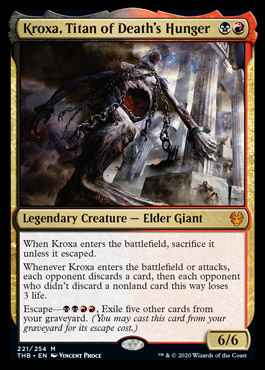
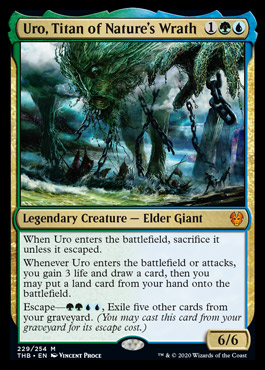
The Titans have a lot of potential. On the front side, in which they’re essentially spells, their effects are reasonable. Two mana for either a Blightning variant or three for an Explore with upside are both reasonable, but getting to do the effect again for just four mana (and then again if they aren’t answered!) is too sweet to pass up. There’s also an intriguing interaction with Lazav, the Multifarious who can become a copy of either of these Titans after they have sacrificed themselves. Players are notoriously bad at evaluating graveyard-based mechanics (Flashback, Delve, etc.), but the Escape cost on these certainly feels low enough to merit playing them. While Uro seems to have an existing shell in Simic Ramp, Kroxa is a bit homeless at the moment. It’s probably not aggressive enough for Rakdos Knights (a deck that also does not have enough natural graveyard fodder), and there aren’t other stand-out Rakdos decks at the moment. It may also see play in Jund sacrifice, but I’m uncertain. Of course, the power level of Theros is certainly high enough to spawn entirely new archetypes, and with any luck Kroxa will be consuming Standard soon!
7. Purphoros’s Intervention
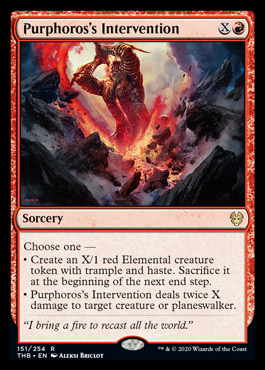
The Intervention cycle is insanely good. Like graveyard mechanics, players have historically underestimated modal cards. Typically, modal cards are filled with options that are fine, but not necessarily super powerful. However, the ability to have a highly flexible card that allows you to choose the most relevant modes in any given situation has consistently made cards into Standard all-stars (think about the Command cycle, for example).
The Interventions take this one step further. Instead of the three options of Commands, they only appear to have two, but that’s a naïve reading of the cycle. The fact that all of these cards are X-spells mean they represent far more options than just the written two. Purphoros’s Intervention is a two-mana removal spell against an aggressive deck, or a four-mana Dreadbore that kills nearly every threat in the format. On the other hand, it creates a giant Fireball creature to close out a game.
People might be low on these now, but they won’t be for long. These cards are incredibly powerful and are going to shape Standard more than we expect. I think Purphoros’s Intervention is one of the two best because it’s an answer at every spot in the curve, combined with a finisher when you need one. It’s also a desperately needed answer outside of Black’s Murderous Rider for high-loyalty planeswalkers like Nissa, Who Shakes the World.
6. Kiora Bests the Sea God
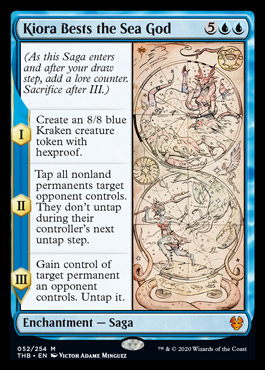
What a fantastic ramp payoff! Currently, Simic Ramp tops out with Finale of Devastation into End-Raze Forerunners, but Kiora Bests the Sea God appears to be a viable, cheaper, and more aggressive alternative. This card comes close to guaranteeing around 16 damage just with the Kraken, but let’s be real – when does Simic Ramp not find a Nissa by Turn 6 or 7? With Nissa, Who Shakes the World lands, Risen Reef, Cavalier of Thorns, and Hydroid Krasis alongside the Kraken token taking advantage of the lack of blockers, this Saga is a powerful closer that ends games fast. The downside, of course, is that it is an easier card to interact with than Finale, especially if Enchantment removal becomes more prevalent.
5. Ox of Agonas
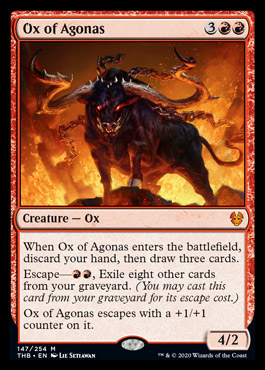
This Ox is a super-cool mashup of Faithless Looting and Bedlam Reveler. First, the obvious application – in Modern, Dredge will happily play the Ox. It’s trivial to fill up the graveyard in that deck, and once an Ox gets binned, Dredge will be able to mill most of its deck with one or two castings of the Ox. This is going to be a really powerful pickup for Dredge that could lead to the deck’s resurgence, especially alongside recent bannings.
In Standard, casting the front side of it is not super appealing. It feels more at home in an aggressive Red or Rakdos deck or in an Izzet Spells deck that is able to dump the Ox into the yard for later refueling. Rotting Regisaur, Thrill of Possibility, or even Drowned Secrets all seem like promising ways to put it in the bin. The payoff is substantial – Ancestral Recall that generates a 4/2 for only RR is a pretty incredible card. The trickiest part is simply going to be finding the right shell to include the card in.
4. Dryad of the Ilysian Grove
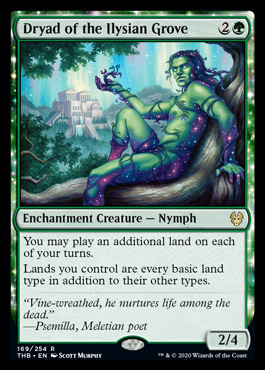
Dryad is a pretty pushed Magic card. It is a Sakura-Tribe Scout/Wayward Swordtooth + Prismatic Omen stapled together on a reasonable body. In Modern this seems like a shoo-in for Valakut decks as well as Amulet builds. Not to mention the 4 toughness and CMC of 3 is, of course, relevant in a world of Lightning Bolt and Fatal Push.
In Standard, this could encourage more splashing in base-Green decks, or we can just jam it alongside Nissa to guarantee that every land is a Forest that produces twice as much mana!
3. Klothys, God of Destiny
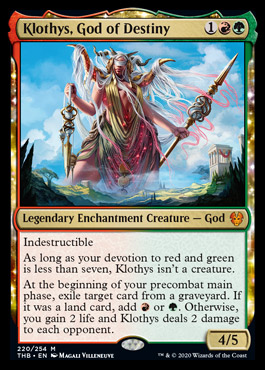
RG Embercleave/Adventures /Aggro in Standard has long been secretly powerful and not-so-secretly been a victim of its horrible mana. With Temple of Abandon entering the format, the aggressive midrange deck will have its mana shored up, and can lean into playing powerful bombs which most certainly includes Klothys, God of Destiny. First-off, Klothys will often be a creature in RG. A Gruul Spellbreaker, a Pelt Collector, and a Zhur-Taa Goblin or Domri is good enough to get Klothys going. Even when it’s not a creature, the threat of it becoming one is a scary possibility that could force opponents into awkward play patterns. Even when just sitting there as an enchantment, Klothys gives RG decks both ramp and reach by sticking a free Deathrite Shaman activation every turn on this RG Theros God. It eats up cards that care about the graveyard, generates value, and does it all on an indestructible beater; I have high hopes for Klothys!
2. Thassa’s Intervention

I have long dreamed of the day where another split counterspell/draw spell was printed, and today is that day finally arriving. But it’s better than that; as discussed with Purphoros’s Intervention, the ability to not just choose the mode, but also choose the value of X makes this card incredibly relevant at every stage of the game beginning on Turn 3. The card draw mode, at worst, is an instant-speed two-mana draw 2, which is unexciting, but entirely acceptable. At its best, it’s a Dig Through Time. The counterspell mode is best compared to Syncopate. On Turn 2, it doesn’t work, whereas Syncopate does. On Turn 3, it matches Syncopate, and on Turn 4 onward, it is better. The wonderful thing about Thassa’s Intervention as compared to Syncopate is that it doesn’t lose its luster in the late game. Because if it’s “twice X,” clause, you’ll often be able to cast this and still have mana left over for something else. This is the card that I personally am the most excited about in the set, but, of course, the biggest problem with it is that Teferi, Time Raveler remains in the format. This card is at its best in a more traditional control deck, which Teferi makes incredibly difficult to play in Standard these days.
1. Heliod, Sun-Crowned
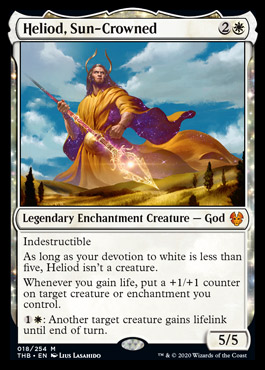
In original Theros, Thassa was the God who saw the most play. Why? Because she was the only three-mana God, was easy to turn on, and had a relevant, combat-oriented ability. Heliod, Sun-Crowned is the White Thassa. Mono-White Aggro has been poking around Standard with its one mana 2/1’s, Venerated Loxodons, and Unbreakable Formations for a while now, but the loss of Benalish Marshal was an enormous blow to the deck. With the introduction of Heliod, it may receive just the boost it needed. The previously unplayable legend, Linden, the Steadfast Queen, becomes a powerhouse, Ajani's Pridemate is far more interesting, and Healer's Hawk, Beloved Princess, Bishop of Wings, Impassioned Orator, Sephara, Sky's Blade, and even Soulmender all merit a second look. Thassa showed us just how easy it was to earn five devotion, and I anticipate that Heliod will play a similar role in a Mono-White Devotion strategy that looks a whole lot like old Mono-Blue Devotion (namely, aggressive, but capable of playing longer games too) from many years ago.
Of course, Heliod can’t be mentioned without also talking about his combo potential with Walking Ballista. If Walking Ballista has at least two counters on it and is given Lifelink, then Heliod + Ballista generates infinite damage and infinite life. People are already talking about the need for a ban in Pioneer, but Wizards will likely wait to see how good the combo really is before axing a card from it. After all, Enchantments and Artifacts do have a lot of hate cards (though Heliod being Indestructible and not always a creature is annoying), but it’s a cheaper, less color-intensive combo than Saheeli Rai + Felidar Guardian was, so I would enjoy your Heliod/Ballista combo while you still can! Which cards are you most excited to play with in Constructed from Theros Beyond Death?
Ryan Normandin is a grinder from Boston who has lost at the Pro Tour, in GP & SCG Top 8's, and to 7-year-olds at FNM. Despite being described as "not funny" by his best friend and "the worst Magic player ever" by Twitch chat, he cheerfully decided to blend his lack of talents together to write funny articles about Magic.










